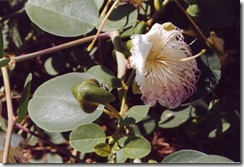 It’s a ritual you don’t see as often as you did a few years ago, but it is good to see the people doing it aren’t just old villagers. The ritual of which I write is the annual assault on the spiky wild plant that grows over so many of our hillsides – the Caper.
It’s a ritual you don’t see as often as you did a few years ago, but it is good to see the people doing it aren’t just old villagers. The ritual of which I write is the annual assault on the spiky wild plant that grows over so many of our hillsides – the Caper.
You don’t crop a caper plant like a vine. You have to have successive visits to it because what you need are the buds, which start small, plump up and then open into quite pretty flowers and they don’t all develop at the same time. It is at the plump, pre-opening stage that they are in the best shape for pickling. Watch the pickers! Their eyes scan the plants and their hands skilfully miss the spikes on the stems as they pick only the plump buds. As they move on you’ll see they’ve left the small buds, as if saying “I’ll come back for you in a few days”.
The caper is a Mediterranean shrub which is found wild in Cyprus but sometimes cultivated, notably in France which even has a town in Provence called Roquevaire known as “the caper capital”. Despite this, and the capers grown, pickled and bottled in Spain and Italy, I reckon there’s nothing to touch a Cyprus caper. They pickle them well here and they’re not too briny. They add flavour and zest to many cold dishes – potato salad, for example, or Salade Niçoise (a great, classic dish, immensely satisfying), and they can enhance grilled or fried fish and give life to a Village Salad, too. This said, a French epicure will disagree with me – in France it is the smallest buds that are most prized; concentrated flavour, probably.
It is strange that this Mediterranean bud is found in an old and famous English recipe, caper sauce. This is made with a Béchamel sauce which itself is made using half milk and half white (meat) or fish stock. As the stock is made (300 ml / ½ pint) a tablespoonful of caper juice or lemon juice is added, and just before serving a tablespoon of chopped capers is added and stirred in. It then accompanies steamed or grilled fish or roast lamb.
Those buds that avoid the pickers flower and then produce a fruit which look very much like a gherkin. These, too, are picked and pickled – the taste is not heavy and similar to that of the buds. Some of the commercially produced jars you buy here contain both pickled buds and fruits.
As well as the English Caper sauce and discreet sprinklings of them over salads, meat and fish, two famous sauces have them as an important ingredient:
Sauce Tartare: Mayonnaise, mixed with finely chopped gherkins, capers and herbs (mint, parsley, chives). There are other variations which may add chopped olives and
spring onions. This is a lovely addition to fried fish or large fried shrimp.
Sauce Ravigote: This is a vinaigrette to which capers and chopped fines herbes are added, and, sometimes pounded hard-boiled eggs. Adds zing to salads.
For the wine lover, care has to be taken with the intake of fruits and vegetables pickled in vinegar or brine – too many can turn the taste-buds against the wine. A cardinal sin.
